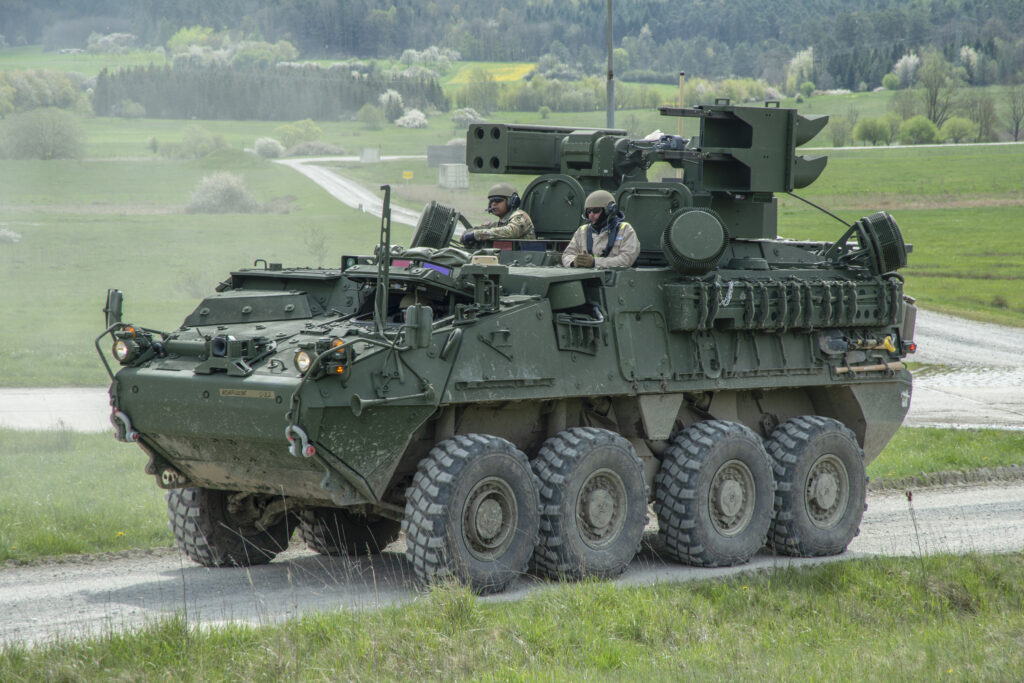
Congress passed a new continuing resolution to avoid a government shutdown tonight, but the legislation locks the Department of Defense at reduced funding levels into early 2024. The unique spending bill, originally proposed by House Speaker Mike Johnson (R-LA), funds eight federal appropriations bills, including defense, at FY23 funding levels through February 2. The remaining four federal appropriations bills are only funded through January 19. Johnson said the staggered approach would give lawmakers more time to finalize FY24 appropriations bills. Most of the resistance to the bill came from the speaker’s own party because right-wing Republicans wanted the CR to contain broad federal spending reductions.
Those cuts ultimately wouldn’t make it through the Democrat controlled Senate, so Johnson relied on support from Democrats in the House to pass the CR by a vote of 395-95. In the end, 93 Republicans voted against the measure. The Senate passed the bill late Wednesday by a vote of 87-11, and President Biden signed it late Thursday night.
A shutdown would have been disastrous for the military, so Pentagon officials can at least remove that concern off their plates. Nevertheless, passage of yet another stopgap spending bill is a frustration for military leaders and budget planners, as it means the military may be operating under last year’s funding levels for at least one-third of the 2024 fiscal year. CRs limit new start programs from moving forward and disrupt contract awards and program schedules. Making matters worse, failure to pass an FY24 appropriations bill by January 1 will trigger a one percent funding cut from the FY23 CR level. However, the sequestration mechanism that implements that cut won’t be triggered until April. A cut of one percent isn’t game-changing by any means, but it represents another potential headache for the military in its annual struggle to get Congress to pass budgets on time.
Johnson has said he has no plans to implement any more FY24 stopgap spending measures, putting pressure on appropriators to finalize the defense budget by February 2. Forecast International examined military acquisition programs that face potential funding shortfalls in the unlikely event of an extended CR if Congress is unable to finalize work on the FY24 budget. A full-year CR would have a major impact on DoD coffers, including in a $7.3 billion shortfall for acquisition programs, as identified by Forecast International’s FY24 Budget Spotlight. Research and development programs account for $5 billion of the potential shortfall, which would hinder the Pentagon’s ongoing trend of bolstering advanced weapons systems development as it prepares for potential conflicts in the Indo-Pacific region.
The Space Force would face the largest funding gap under a full-year CR, losing out on $2.6 billion worth of research dollars. The Air Force’s RDT&E budget would be short $1.4 billion, including a $790.6 million shortfall for the Survivable Airborne Operations Center; $668.5 million for Next Generation Air Dominance fighter; and $375 million for advanced engine development that will power the future NGAD aircraft. The Navy would be subject to a $1.5 billion reduction for RDT&E programs.
Other RDT&E shortfalls would include $1.5 billion for Defense-Wide programs, $1.4 billion for the Air Force, and nearly $1 billion for the Navy. Notably, a classified Special Access Program called Link Plumeria would miss out on $1.1 billion in planned funding growth if lawmakers fail to pass an FY24 defense appropriations bill. It’s believed this program is supporting work on the Navy’s own NGAD program, also known as F/A-XX, which will replace the Super Hornet fleet. Funding for this classified program element has typically remained below $400 million per year, but it is now expected to ramp up to around $3 billion per year, suggesting a sharp increase in F/A-XX development funding. The Army’s research budget would actually be overfunded under a year-long CR, but several programs would still be left with less funding than planned, including $441.7 million for the XM30 Mechanized Infantry Combat Vehicle (formerly the Optionally Manned Fighting Vehicle), which will be made by either General Dynamics Land Systems or American Rheinmetall Vehicles. RTX’s Lower Tier Air and Missile Defense Sensor would be short by $436.5 million.

Several procurement accounts positioned for growth in the FY24 budget would also face headwinds under a prolonged CR. Air Force missile funding more than doubles in the FY24 request compared to FY23 enacted levels, meaning that account would lose out on $2.5 billion in planned growth. The FY24 request included around $770 million in advance procurement for Lockheed Martin Joint Air-to-Surface Standoff Missiles (JASSM) won’t materialize under a CR. Another $539.3 million for advance procurement of long lead parts for the Sentinel ballistic missile being built by Northrop Grumman is also reliant on passage of a final FY24 appropriations bill. The Air Force doesn’t plan to buy the first Sentinel missiles until FY26, but the procurement of long-lead parts is necessary to ensure on-time production. The CR also underfunds F-35 and B-21 procurement by $797 million and $673.5 million, respectively.
An extended CR would result in a $2.4 billion cut for the Navy’s “Other Procurement” account, which funds electronics, ship improvements, and other miscellaneous equipment. Within that account is a funding line for ship maintenance, repair, and modernization, that would face a $1.1 billion shortfall. The Virginia class submarine would be impacted, while the Columbia class sub got a reprieve in the initial CR passed in September. A long-term CR would also reduce the number of Lockheed Martin Long-Range Anti Ship Missiles procured in FY24 and cut advance procurement funding requested to ramp up production of RTX’s SM-6 missiles in FY25. A request for expeditionary loitering munitions under the Navy’s GOALKEEPER program would also fail to get off the ground without full FY24 appropriations.
Several Army missile programs are held back by CR-level funding. Investment in the service’s Indirect Fire Protection Capability would be reduced by $294.3 million compared to the requested amount. The IFPC effort involves the procurement of Enduring Shield air and missile defense systems from Dynetics, owned by Leidos, along with AIM-9X interceptors from RTX. The Army also wants to buy 22 Maneuver Short-Range Air Defense (M-SHORAD) systems in FY24, but CR-level funding would only support 13 systems. General Dynamics Land Systems, Leonardo DRS, and Moog are major contractors involved in the M-SHORAD Increment 1 program. A long-term CR would also prevent the Army from ramping up production of Precision Strike Missiles (PrSM), which are manufactured by Lockheed Martin to replace the Army Tactical Missile System (ATACMS). The Army procured 72 missiles in FY23 and plans to buy 110 in FY24. Annual procurement is expected to grow to 242 by FY28, but the service could seek additional missiles to replace ATACMS being donated to Ukraine.

None of these outcomes are set in stone, and Congress is ultimately expected to pass an FY24 defense appropriations bill, albeit later than desired. Nevertheless, it’s easy to see the disruption that would be caused if lawmakers fail to act on the FY24 defense appropriations bill over the next two months. Furthermore, contracting process for these programs, among others, can still be disrupted under the stopgap spending bills that have already been put in place, potentially resulting in delayed contracts and program cost growth. Drafting the annual budget request is a long and complex process, and the lack of an on-time appropriations bill disrupts next year’s FY25 budget request. Program managers don’t know how much funding they have to work with without enacted funding at the start of the fiscal year, making it more difficult for them to calculate future funding requirements. Annual budget requests are supposed to be released in early February, but delays in finalizing the FY24 budget are likely to push the release of the FY25 request back to April or later due to the prolonged CRs.
The recently-passed CR also doesn’t address the $106 billion supplemental request from the Biden administration that seeks aid for Ukraine, Israel, Taiwan, and U.S. border security. That legislation will have to be addressed separately, and President Biden has called on Congress to pass the supplemental aid bill as soon as possible.
Additional data insights from the ongoing budget process can be gathered using Forecast International ‘s FY24 Budget Spotlight, which will be updated with future conference authorization and appropriations funding totals from Congress. Use the registration link to access the free dashboard.
More Defense Budget Data
Forecast International’s U.S. Defense Budget Forecast makes it easy to navigate the latest U.S. defense budget. The product features sorting and data visualization options and presents the entire Future Years Defense Program (FYDP) through an online interface with downloadable spreadsheets. This is the go-to service for anyone looking to save time and energy in navigating the massive Department of Defense budget.
Shaun's deep-rooted interest in military equipment continues in his role as a senior defense analyst with a focus on the United States. He played an integral role in the development of Forecast International's U.S. Defense Budget Forecast, an interactive online product that tracks Pentagon acquisition programs throughout the congressional budget process. As editor of International Military Markets – North America, Shaun has cultivated a deep understanding of the vast defense markets in the United States and Canada. He is a regular contributor to Forecast International's Defense & Security Monitor blog and has co-authored white papers on global defense spending and various military programs.



